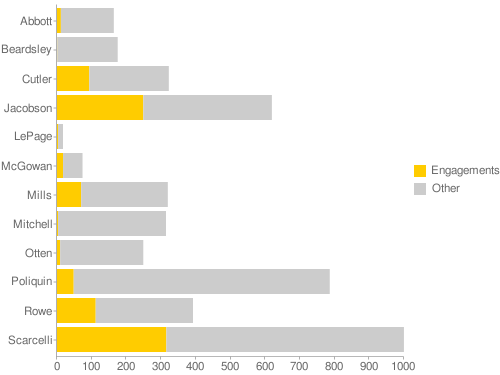Derek Viger made an interesting observation yesterday on his Twitter account:
Today’s most active #megov tweeters seem to be @rosascarcelli and @Abbott4Governor Does this point to something?
Frequency is a good measure of confidence and passion on Twitter. Sure, there’s the argument of quality versus quantity, but in general it seems to be more valuable to keep your followers up-to-date more often than not.
But Twitter isn’t all about broadcasting. For me, the real value of Twitter is the possibility of engagement; a candidate has the ability to easily address questions and criticism from other Twitter users. How would the candidates stack up if engagement was taken into account?
I ran a quick analysis of each major party candidate’s Twitter account. Here’s how it breaks down:

The numbers above aren’t perfect; unfortunately, they don’t include new-style retweets and seem to be missing a few others, too (ah, the wonderful quality of the Twitter API). I defined “engagement” as any tweet that began with @ or that included an @ preceded by a space (to filter out email addresses). It seems to be pretty accurate. (The chart above was made with the Google Chart Generator. Great tool.)
UPDATE: Lyle notes that I didn’t include Eliot Cutler’s tweets in the data. I’d originally only geared the post to primary candidates, but it’s a fair point and I’ve added him to the chart. Derek asked about engagements as a percentage of the total number of tweets, and they’re as follows: Abbott, 7%; Beardsley, 1%; Cutler, 29%; Jacobson: 40%; LePage, 18%; McGowan: 24%; Mills: 22%; Mitchell, 1%; Otten, 4%; Poliquin, 6%; Rowe, 28%; and Scarcelli, 32%. As a whole, 25% of the Democrats’ tweets have been engagements; Republicans have engaged with users in 17% of their tweets.